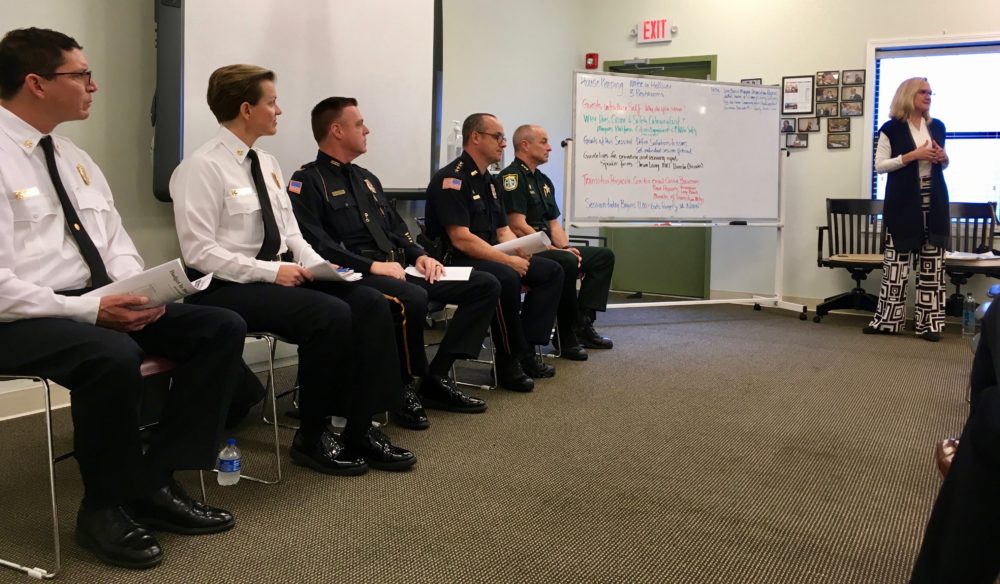
Pathways for Change CEO Connie Bookman headed the public safety category for the mayoral transition team. Here are explanations for her recommendations.
•Make a dedicated investment in training and development of first responders
Department Chiefs, their leadership teams and front-line staff talked about how each department experienced a large number of retirements or turnover (25 or more each) in the past five years and how this mass exodus diluted the institutional knowledge needed for continuity of service. Who was continuing education, mentoring, and training our boots on the ground police officers and firefighters?
In the past 14 months alone, PPD officers have seen a combined 62 training requests denied.
In the past 14 months alone, PPD officers have seen a combined 62 training requests denied. The value of all those trainings denied, combined, was a mere $37,139. This does not factor in the many officers who expect a “no†and don’t even file a request for training as they expect a denial. The entire training budget for more than 150 officers is about $131,000—less than $1,000 per officer in the field each year.
To make matters more frustrating for police, the PPD union contract provides a pay incentive for officers to continue to learn. A lack of dedicated funds for training means we are not only telling city officers that their development isn’t important, but we’re prohibiting them from a reward already installed to inspire them to seek training and development.
For police, one possible funding stream would be allowing the PPD to use lapsed salaries— salary already budgeted for an open staff position—for training dollars in that year when available.
Investment in PPD training could create cost savings immediately. When the city is sued over a police-involved issue, one of the first questions asked is about the amount of training the officer in question had.
“Experience is what you get right after you needed it.â€
Fire Chief Cranor
When Pensacola Fire
Department Chief Cranor mentions training,
she says “Experience is what you get
right after you needed it.†It’s
a sobering statement.
The Fire Department has had to tackle the challenge of retirements, loss of institutional knowledge, succession planning, disaster preparedness, and health and safety concerns head on.
The Fiscal Year 2019 budget total to cover fire suppression, rescue, and hazardous materials continuing education and professional development? Just $14,200. Those numbers just aren’t enough.
During the past economic downturn (and required budget cuts), the PFD Health and Safety Battalion position was taken away and merged with the Training Battalion’s position. This leaves one Chief Officer (with no staff) to ensure that required training, development, and best- practice safety mandates get implemented. Also, during the recession crisis, an Administrative Branch Chief Officer was eliminated, leaving the Fire Chief as the direct supervisor of the entire Administrative Branch. This, while also performing the duties of Disaster and Emergency Management Coordinator for Pensacola.
These consolidations minimize the critical importance of disaster planning and emergency management for an entire city. In addition to training dollars, funding the Planning/Safety Battalion Chief allows the Training Battalion Chief to provide focus solely on training and response plans. It also allows the Fire Chief to focus on the department’s preparedness, transition/succession planning, grant writing, and to ensure budgeting reflects the department’s needs.
Not least of all, this position fulfills both FEMA and Homeland Security requirements for emergency management planning, allowing for the strategic planning and forecasting of needs and preparedness for an all-hazards fire department as required by the US Department of Homeland Security.
If dollars are earmarked specifically for training and development, the city should not only see an immediate return with more experience patrolling our city, but these investments in people lower turnover and increase employee engagement—both saving taxpayer money. Happy first responders equal harder, more efficient work, and happier citizens. I see a dedicated, earmarked budget for first responder ongoing training as the top priority, and an investment the city cannot overlook.
• Complete a comprehensive compensation, equipment and staff level study.
I recommend that Mayor Robinson and the City Council approve a study for an outside company to review three important topics specifically within the next 90 days:
- Compensation, Benefits and Pensions. Are we being competitive with similar cities or is our pay scale allowing for less experience, more turnover and disengaged employees? Are we being fair to our departments as far as pension goes compared to others
- Equipment. Our police and fire departments have aging fleets that likely need a boost much quicker than the equipment is scheduled. How does the age of our vehicles stack up to others? This can affect turnover and public safety immensely. Do PPD and PFD have all the tools to do their job sufficiently? What equipment are the departments missing that could cause a disaster down the line? I concurrently recommend the city review and possibly expedite some key and obvious equipment needs and not wait for a completed study. I have included the current status of equipment in both departments in Crime Appendix A as stated by the leaders of the respective departments.
- Staffing Levels. Do we have enough people on staff in police and fire to keep us safe? This section obviously is impacted by turnover and compensation as well, but we should ensure our city has the proper staffing levels and not to rely on just past precedent in assuming that our growing community is meeting those needs.
For example, the Pensacola Police Department had 30 open police officer positions during the past several years so they shut down specialized units and cut staffing levels in every division. The DUI Squad, Street Crimes Unit, and COPS Unit were shut down completely.
The DUI Squad, Street Crimes Unit, and COPS Unit were shut down completely.
All of the work performed by these units was spread throughout the department and every employee was tasked with additional job assignments. This type of restructure leads to burnout and poor morale.
It’s time to do a study of our first responder resources with current and modern metrics. For example, we technically had a larger city population in 1990 than we do today. Does that mean we need less officers? No. It does not factor in the downtown surge of visitors from outside the limits. It doesn’t factor all the businesses and people who inhabit our city limits each day and live elsewhere like Gulf Breeze or 9 Mile Road. Think about how much our downtown has changed in terms of vibrancy since 1990. Logic suggests our city limits are busier than ever before, yet our staffing levels have remained flat.
It would likely be much more accurate to judge the needs of our departments based on call volume and response times. Though the population of our city decreased, the number of visitors into downtown increased, meaning more drivers are passing through the city each day. We should use these metrics to compare to other cities.
Here is an example of why staffing and compensation studies matter. Dispatch operations had five vacant positions in 2019, and because of this, the city paid 800 hours of overtime. Burnout and fatigue will eventually create hardship.
If I were to
call 911, I want that dispatcher to
answer and process my call and get it to the first available responder. A wait time to process a call can mean the
difference of life or death. Are we paying competitively? It’s worth a look when lives are on the line.
Since 2005, PFD has lost 27 experienced, qualified firefighters to other fire departments.
The Pensacola Fire Department faces a critical challenge of recruiting and retention. Since 2005, PFD has lost 27 experienced, qualified firefighters to other fire departments. Maybe they returned to a hometown, or left for better salaries or benefits? Maybe because the other department had more capabilities—more ways for a firefighter to do the job?
Can our city fund the level of services, programs, benefits and salaries that entice qualified candidates to choose—and remain with—PFD? This study will provide those answers.
There are certain facts we must face. As the city grows—more construction, more citizens, more businesses—so does the responsibility to keep us all safe. From the increased number of building inspections to higher emergency call volume, the Fire Department is impacted. Another fact: Disasters will happen. Hurricanes, for one, present real threats not just to Pensacola, but to our region. The best way to recover from any disaster is to be prepared. The US Department of Homeland Security provides a National Response Framework and FEMA set up a National Preparedness Goal for cities across the country (see Crime Appendix A).
Meeting the demands and goals of these response and preparedness initiatives puts Pensacola in the best position to prevent, protect against, respond to, and recover from disaster. This preparedness should be a key focus area for the department and not simply a tacked-on responsibility.
Create a committee to address panhandling with a solution by June 15.
I was asked an interesting question at a recent public forum, “Do we have so many panhandlers in Pensacola because we have so many resources for the homeless?â€
That question made me cringe. Because in my 30 years working with homelessness, understanding their stories and their desire to live full lives, the behavior I see and hear about of people who panhandle are two very different populations.
As we say at Pathways For Change, “every life is a life worth saving.†Our mission is to reach those who have lost their lives to addiction, mental illness or the terrible life circumstances that brought them to the point of homelessness. Our doors are open to everyone who wants help. So are so many other non-profit organizations.
I do agree with the woman when she mentioned Pensacola’s plethora of services. We have so many dedicated people who choose a career to make a difference in the lives of the disadvantaged.
We have so many good-hearted citizens who give their personal earnings to fuel those non- profits. Just call 211 and ask what is offered in our city for those who need help.
Lakeview Center is one of the
largest mental health facilities in
our state and if you want help,
they can provide addiction and mental health
treatment.
Opening Doors, formerly called the Homeless Coalition offers comprehensive case management.
Reentry Alliance of Pensacola connects daily with men and women reentering our community from jail or prison. They provide housing, transportation to day labor, and wrap around services that allow a person to live and thrive within our social norms.
Local attorney Will Dunaway, who is knowledgeable on this issue and who supports the men and women living in the Satoshi Indian Homeless Camp, describes what his homeless friends call “the country clubâ€: The Alford Washburn Center offers a place to shower, wash clothes, store personal belongings, a place with an address to receive mail, be it a disability or Veterans Administration check or a way to connect with family or a support network.
Waterfront Rescue Mission has incredible, far reaching and long-term services for the homeless. United Ministries serves individuals and families who are just days away from homelessness. They give, not only a check to pay back rent, utility bills and the like, but they spend time with their clients teaching them about predatory lending schemes or other practices that will drain their resources and put them back in financial jeopardy.
During my December ride along with the PPD, our first run was to a downtown business. The owner called and was concerned about his employees going home for the evening. A man who panhandles during the day habitually camps out behind his business at night, shouting obscenities to any person who walks by or exits his salon.
Another business owner relates to this dilemma. A man who panhandles outside his business used his bathroom facilities one day, defecating and smearing feces all down the hallway. He had to shut down operations for a day—a vastly expensive measure with no way to recoup the lost revenue—to remove human feces from his establishment.
We can all agree that the lives of people matter.
That employer and those employees? They deserve a right to live in peace. They have rights to make a hard-earned wage, to get to their cars without fear and go home to their families. We often overlook this point because those people may be living more stable lives, but that shouldn’t disqualify business owners and employees from the rights they deserve as well.
And of course, that man who panhandles has a right to the same peace. Neither has more rights than the other.
It’s time for our city to be a leader—and have a plan—in defining what is a peaceful norm in which to live. We have to stop being co-dependent. My recommendation is that by April 15, Mayor Robinson create a committee to study the complex panhandling issue in our city. We have been stuck in a cycle of either inactivity on the issue or swift decisions that have proven unsuccessful.
This committee, which should operate transparently in the
Sunshine, should be made up of 13
people and last 60 days with the clear and defined outcome be to bring a solution to the mayor and City Council by June 15, 2019. I strongly recommend that it study what other cities have done recently including St. Augustine, Daytona Beach and Dallas.
I would suggest a member from Alfred Washburn, United Ministries, Waterfront Rescue Mission, Lakeview Center, Pathways For Change, Re-entry Alliance of Pensacola, Opening Doors, the ACLU, the Downtown Improvement Board, The District 3 County Commissioner Lumon May, District 6 City Councilwoman Ann Hill, City Planning and the Pensacola Police Department.
This should not be a one-sided committee, and we know there are spirited and passionate voices on both sides of this issue. We have to face the reality that consensus may not be possible, and to that end, the committee should still do its best to come up with the best possible solution for the leaders of our city to decide on and enact.



